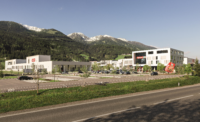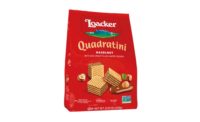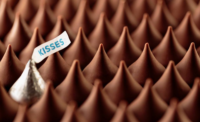Three years can be a very long time. Or, in some cases, a blink of an eye. But it was almost exactly three years ago, that Ulrich Zuenelli, chairman of A. Loacker AG/Spa, and I were enjoying a wonderful meal at Vögele restaurant in Bolzano, Italy. And it was then that he told me that the company’s board of management had approved construction of a third plant, one adjoining an existing facility, to be built in Heinfels, Austria.
So there I was, blinking my eyes, partly from a bit of jet lag, partly from the morning sun rising over the mountains, as I was being chauffeured to the grand opening of Loacker’s dazzling new plant, which was held several months ago on June 25. Built in the same architectural style as its sister facility — white facade, plenty of natural daylight, energy-saving enhancements, top-of-the-line processing and packaging equipment — the new structure proved to be…well…huge is a good word.
Of course, you can’t really tell driving up to the plant that it covers 16,000 sq. meters (172,223 sq. ft.) of floor space and has a total floor area of 36,000 sq. meters (387,501 sq. ft.). Or as Frank Hess, managing director for Loacker Heinfels, explained, 36,000 sq. meters is comparable to five football pitches, I mean five soccer fields.
But that’s not readily evident as one drives up to the front of the building, which is relatively narrow compared to its length. So after I donned my press pass and walked up the few steps to what is a holding area for shipping products out, I was anxious to see what the inside looked like. Well, the first reaction was, “Wow!”
The Loacker team had transformed a gleaming white staging and shipping area into a reception hall for 320 guests. It was complete with standup cocktail tables, a musical duo, coffee and cake service, even a pair of dwarf-mascots — the Loacker Nanetti — who have been the brand´s ambassadors since 1984 and were inspired by the region´s rich heritage of tales and legends.
Rows and rows of chairs faced a small stage with a podium for remarks framed by a beautiful backdrop showing Sciliar Mountain. Of course, the Sciliar Mountain backdrop is the same view workers have at Loacker’s headquarters’ facility in Auna di Sotta, Italy. And it also appears prominently in the company’s logo. Nice touch.
I was one of the early ones to arrive, the drive from Sporthotel-Sillian being less than five minutes. Consequently I had some time on my hands before the ceremonies started. Amidst reacquainting myself with members of the Loacker-Zuenelli family, including brother-and-sister board members Christine Zuenelli and Armin Loacker as well as Andreas Loacker, Armin’s son, I sat down and started to study the opening speeches.
Lara Consoli, communications manager for Loacker, had graciously translated the speeches from German into English. The first to grace the podium was Ulrich Zuenelli, not only chairman of the company and Christine’s son, but my meal mate from three years ago. After welcoming state and local officials as well as various dignitaries — and there were quite a few — Ulrich expounded on the reason for the day’s ceremonies.
“Today, we can look back on an unbelievable export growth of 22 percent per year on average for the last 10 years,” he explained. “This means that we generate more than 70 percent of our volume sales outside our Italian home market and 65 percent of our revenue outside the European Union!
“This is proof that it is possible to capture world markets from Central Europe, even as a medium-sized family business with a consistent, quality-oriented differentiation strategy under an authentic brand.”
May I also add significant reinvestment into the business — €70 million for the new addition and a total of €160 million in the area during the past 10 years.
As Andreas Loacker, head of research and development for the company, subsequently pointed out to the guests in attendance, “This must be the biggest project Loacker has ever undertaken.”
Hess and Carlo Raggi, head of engineering and overall project manager, elaborated on Andreas’ remarks with additional details, everything from the 30-month construction schedule and the 37.5 kilometers of piping used to the 350,000 liters of heating oil saved as a result of construction techniques and heat-recovery systems.
Then there was that matter of the Mühlbach creek. As Raggi explained, one of the challenges the crew faced was flood protection for the outdoor facilities.
“To prevent the new production hall from blocking the valley like a concrete barrier, we had to build a channel on the southern side and build up the dam,” he says. “At the same time, the Mühlbach creek at the northern side was relocated. This allowed us to increase the useable site area and we expanded the “Loacker Store” (retail café and brand store) parking area by more than 150 percent.”
Oh, yes, then there was the snow. Plenty of it. As Hess revealed, the area received so much snow during the previous winter that the crew had to halt construction. A break in the weather in February allowed Loacker to begin the process of removing the snow, 20,000 cubic meters of it. The new “Heinfels glacier” topped out at 15 meters and took until August to thaw.
It was becoming clear that the Heinfels addition was no ordinary undertaking.
Nonetheless, as Raggi later told me, “The project was completed on-time and on-budget; now I can sleep at night.”
Of course, when you have 320 guests on hand, it can take a little time to complete tours for everyone. There were 16 of them, in fact, the last one — mine — ended the day’s festivities. Fortunately, I received a personal tour from Bernhard Origer, head tour guide and pastry workshop specialist. As I mentioned earlier, the building didn’t look that big from the front. But trust me, it does feels like you’ve crossed five soccer fields.
Thanks to Origer they were keeping the wafer lines running till I arrived. Currently, there are two Hass wafer oven lines, three Haas creaming units and one Sollich enrobing line feeding very sophisticated packaging machines co-engineered by Rowema and Loacker. The plan calls for two more oven lines next year, eventually expanding to 10 upon need. And yes, there’s even room for a chocolate moulding line.
As one would expect, the new factory incorporates Loacker’s famed standards for the latest and greatest and most environmentally friendly technology. The infrastructure reflects that same commitment.
As Raggi explained, “During interior and exterior construction, in addition to high standards of hygiene and product safety, we attached great importance to the longevity of the building. In order to minimize operating and maintenance costs long-term, we implemented an easy-care design. In the area of heat insulation, we chose an unusually high standard for the industry, with 20-cm. thick façade insulation and triple glazing.”
The plant, like its predecessors, uses a heat recovery system that captures oven air. Last year the system saved the equivalent of 350,000 liters of heating oil. So too, with cooling. An environmentally friendly ammonia system is used, complete with heat recovery. Four out of total seven planned ventilation stations provide the right temperature and humidity for every production area.
“For such a sensitive product as a Loacker wafer, it is essential that the ideal temperature and humidity are maintained at all times,” Raggi explains. “That is the only way for our product to reach the consumer with the desired crispness and intense flavor.”
Certainly seems to be working, given Loacker’s 10-year growth sequence. Moreover, it’s not by happenstance.
As Ulrich explains, the company bases it future growth on three major strategies: internationalization; innovation and diversification; and vertical integration.
“Our goal is to develop and penetrate international markets,” he says. “Currently, we export to more than 100 countries across five continents. There’s plenty of room to grow and we’re enjoying success in the Middle East, Asia Pacific and Americas markets.”
As for innovation and diversification, Loacker has two assets most companies don’t: Armin and Andreas Loacker, a father-and-son team steeped in product development and manufacturing experience as well as a penchant for what I would describe as “wafertivity” — a creative approach to coming up with wafer-based confectionery products.
Beginning with the company’s premium and classic wafers to such evolutions as the snack-sized Quadratini to the most recent Cocoa & Milk creations, the company refuses to renege on its wafer tradition by being complacent.
Its commitment to innovation through diversification is seen in its chocolate specialty lines, beginning with the Rose of the Dolomites pralines and continuing with the Gran Pasticceria Tortina and the Loacker Chocolate Bar lines. As such, the company is quickly establishing itself as a premium chocolate player.
Currently, 65 percent of the company’s product line involves wafers, the remaining 35 percent chocolate specialties. There’s no doubt that the chocolate specialties portion will continue to grow.
“After our first full year [2014/2015] of introducing our chocolate bars, we were able to make substantial inroads in several markets within the highly competitive chocolate bar segment, such as Italy, Israel, South Korea and Germany,” says Ulrich.
And there’s the vertical integration. That process first took shape in 2008 when Loacker opened its first Loacker Store, a uniquely Italian hybrid of a coffee shop, pasticceria (pastry shop) and retail outlet, offering consumers pastries, coffee and a limited cafe menu consisting of sandwiches and pasta. Most importantly, the Loacker Stores provide consumers an opportunity to review and purchase the entire Loacker product line, a critical tool in further integrating the brand amongst consumers.
Today, the company operates five retail units throughout the South and East Tyrol regions (northeastern Italy and southeastern Austria) and has created a franchising niche for the shops now known as “Points.” The first franchise unit will open in Trentino, Italy this year.
Still early in the launch, Ulrich believes that the concept can provide another important vehicle for growth for the company. He cites the Loacker brand and its Loacker Store as ideal partners for the franchising concept, enabling entrepreneurs to succeed based on proven and successful company-run operations. He affectionately calls it Loacker Store 3.0.
The company has also begun to implement a vertical integration strategy, one that begins with sourcing, such as the planting of hazelnut trees on 54 hectares (135 acres). Ulrich says plans call for doubling the acreage during the next two years.
“Our goal is to develop agricultural know-how and then contract out with farmers, sharing with them the know-how we’ve acquired,” he explains. The company also looks to pursue ownership of additional farm lands for other ingredient needs.
So what does the future hold now that the third plant has been built? First, it revolves around bringing the facility to maximum production capacity, which means 10 wafer ovens, 20 packaging lines and eight chocolate enrobing lines.
“In order to keep up with oven production capacity, we need to have a 2-to-1 ratio for the packaging lines,” Ulrich says. “Our long-term blue print also calls for a chocolate moulding line.”
“The key is flexibility,” adds Hess.
And that also extends beyond manufacturing, from the chairman’s office to the plant floor.
“Our major challenge has been managing growth,” says Ulrich. “We’ve experienced growing pains on an organizational level, on a human resources level, on a change management level.”
It’s been a case of “permanent change in process,” adds Hess. “You have to adapt your work, what you do and how you do it.”
Thus, the Heinfels addition isn’t only about meeting demand by adding production capacity; it’s also about being flexible enough to meet marketplace changes and shifts. On a corporate level, it’s all about being agile.
“We have a saying here, ‘What rests, gets rusty,’” quips Ulrich. No concern for Loacker; it looks to be a well-oiled and responsive machine.
At-a-Glance: Loacker AG/Spa
Sales: €313.71 million (2015)
Employees: 864
Headquarters: Unterinn (Auna di Sotto), South Tyrol, Italy
Plants: 3 (total) 1 - Unterinn/Auna di Sotto, South Tyrol, Italy ; 2 - Heinfels, East Tyrol, Austria
Product portfolio: 65 percent wafers, 35 percent chocolate specialties
Exports: 70 percent; more than 100 countries (Middle East, Africa, USA, Asia, Europe
Output: 850 million units (2015)





















